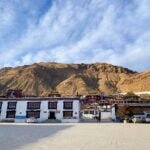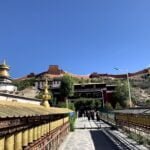The Drepung Monastery is situated in the western part of Lhasa, below Mt. Gambo Utse. It is encircled by the dark mountain and its resplendent ivory edifices sparkle in the sun. It covers an area of about 250,000 square meters. Constructed in the year 1416, it is deemed one of the most extensive monasteries among the six primary monasteries of the Geluk Sect in Tibet. Before the renovation of the Potala Palace, the Drepung Monastery served as the residence of the Dalai Lamas.
History of Drepung Monastery
The Drepung monastery was established in 1416 by Jamyang Choeje Tashi Palden, a devoted follower of Tsong Khapa. Despite being from a humble background in Lhoka, Jamyang Choeje excelled in his studies and became an expert in sutra before mastering the Esoteric sect. Tsong Khapa entrusted him with the task of constructing a grand monastery to disseminate his teachings, presenting him with a conch shell as a symbol of good fortune. With the support of a noble family, Jamyang Choeje began the construction of the monastery, which he named “Palden Drepung Gonpa” meaning Rice Heap in Tibetan. Upon its completion, he was appointed as the first Tripa (throne holder). In 1464, colleges were established to teach tantra in the monastery.
The second Dalai Lama constructed the Ganden Phodrang palace within the monastery when he became abbot of the monastery. The third Dalai Lama was invited to the monastery as the first living Buddha, after which he went to Qinghai to preach, earning him the title “Ocean of Wisdom” bestowed upon him by Atai Khan, the leader of Mongolia. This led to the Title of Dalai Lama. Following this, he posthumously recognized the first and second Dalai Lamas. The fifth Dalai Lama also lived in the monastery until he obtained both political and spiritual power.
The Drepung monastery holds a significant place in the history of Tibetan history due to its esteemed status and profound impact. The Ganden Podrang Palace, located within the monastery, is considered the place where the Gelug Sect assumed administrative power, as it was the residence of the Dalai Lamas.
Drepung Monastery Architecture compound
The Drepung Monastery comprises the Tsokchen Hall, four Dratsangs and Gandan Phodrang. These sections also have their corresponding associated Kamtsen, monks’ residences, and other structures, creating well-organized construction units.
Each construction unit’s interior is mainly divided into three levels: the courtyard, sutra hall, and Buddha temple, forming an ascending position from the gate to the Buddha hall. The exterior of the hall and sutra hall is ornamented with Buddhist themes like the golden roof, phase wheel, treasure building, eight treasures, etc., which boosts the solemnity of Buddhism and creates a large-scale architectural group with a stunning scale.
The view of the group of floors is magnificent, one after the other, resembling a beautiful mountain city. As per the Tibetan tradition, visiting the Drepung Monastery requires following a turning path that rotates clockwise from left to right. Generally, visitors should first go to Gandan Pozhang, then to the Tsokchen Hall, followed by the Tantric courtyard, and then from the back of the mountain to the foot of the mountain. At the foot of the mountain, there is Naichung Temple.
Exploring the Wonders of Drepung Monastery: A Spiritual and Architectural Marvel in Tibet
Drepung Monastery, nestled in the mountains of Tibet, is a treasure trove of spiritual history and architectural splendor. This ancient monastery is not just a religious site but a journey through the annals of Tibetan Buddhism.
The Grandeur of the Tshomchen (Main Assembly Hall)
- Architectural Magnificence: At the heart of Drepung Monastery lies the Tshomchen, covering 4,500 square meters and supported by 183 pillars. This main assembly hall is an architectural marvel, embodying the essence of Tibetan craftsmanship.
- Sacred Art and Relics: Inside the Tshomchen, visitors can marvel at an array of Thangkas and murals that create a profound religious ambience. Lifelike statues of Tsongkhapa and his disciples add to the spiritual aura of the hall. A particularly revered artefact is a conch shell, believed to have been used by Sakyamuni and later discovered by Tsongkhapa.
- Tomb of the Dalai Lamas: The back of the palace holds silver tombs dedicated to the second, third, and fourth Dalai Lamas, each a piece of the monastery’s rich history.
The Ganden Potrang: A Historical Residence
- A Palace of Significance: Ascending the west staircase, visitors will encounter the Ganden Potrang, a three-story palace established during the era of the second Dalai Lama in 1530. This palace, with its distinctive flowered windows, once served as the residence for the Dalai Lamas from the third to the fifth.
The Four Tantric Colleges: Centers of Learning
- Hubs of Buddhist Education: Drepung Monastery houses four Tantric colleges – Loseling, Ngapa, Deyang, Gomang, Shakor, and Thosamling. Each college boasts its own chanting hall and temple, creating a unique atmosphere of learning and devotion.
- Rigorous Study and Examination: The monastery’s education system is intense, with monks engaging in regular study sessions, recitations, and debates. The culmination of their education is an examination conducted by the Khenbu, determining their ranks and eligibility for the prestigious Geshi degree.
Experience the Spiritual Essence of Drepung Monastery
- A Journey into Tibetan Buddhism: Visiting Drepung Monastery offers a unique opportunity to delve into the depths of Tibetan Buddhism, its traditions, and its rich historical legacy.
- A Haven for Cultural Enthusiasts: For those interested in religious history, architecture, and Tibetan culture, Drepung Monastery is an indispensable destination.
In summary, Drepung Monastery stands as a beacon of Tibetan Buddhism, offering visitors a profound insight into the spiritual and historical heritage of Tibet. Its architectural wonders, sacred relics, and centres of learning make it a must-visit site for anyone looking to explore the rich tapestry of Tibetan culture and spirituality.
Drepung Monastery: A Journey Through the Ganden Phodrang Palace and Tsokchen Assembly Hall
Drepung Monastery, a cornerstone of Tibetan Buddhism, is home to the illustrious Ganden Phodrang Palace and the majestic Tsokchen Assembly Hall. These structures are not just architectural feats but also repositories of spiritual and historical significance.
The Ganden Phodrang Palace: A Blend of Spirituality and Governance
- Three-Section Layout: Viewed from above, the Ganden Phodrang Palace reveals a three-section layout, each part contributing to its grandeur.
- Entrance and Courtyard: Entering through the front door, visitors find themselves in a quaint courtyard, flanked by a two-story office space on the left and an ancient, winding tree to the right.
- Phodrang Courtyard and Buildings: Climbing the courtyard steps leads to the Phodrang courtyard, surrounded by two-story buildings, including corridors and living quarters.
- The Phodrang Building: At the compound’s rear, the Phodrang Building stands elevated, with its sutra hall on the first floor hosting numerous Buddhist halls. The second floor, a hub for the Dalai Lama’s political and religious activities, houses the fifth Dalai Lama’s throne and living quarters, complete with meditation and sutra rooms.
Tsokchen Assembly Hall: The Heart of Drepung Monastery
- Expansive and Sacred: The Tsokchen Hall, central to Drepung Monastery, spans 4,500 square meters. A stone-paved square of 200 square meters precedes the hall, leading to a bright corridor supported by 8 columns.
- Architectural Marvel: The hall’s sutra hall, with 221 rooms and 183 columns, covers about 1,800 square meters. The highlight is a large skylight, illuminating the intricately carved beams and painted buildings that drape from the columns.
- Artistic Grandeur: The hall’s interior is adorned with gold bronze statues, long oil lamps, and vibrant mantles, creating an awe-inspiring visual experience.
Buddhist Art in Tsokchen Hall
- Exquisite Buddha Statues: The hall houses remarkably lifelike Buddha statues, including a centrally placed Bodhisattva and a large white umbrella that gracefully covers the Buddha. The statues’ intricate craftsmanship and backlighting enhance their spiritual presence, making them artistic masterpieces.
Visiting the Ganden Phodrang Palace and the Tsokchen Assembly Hall in Drepung Monastery offers a glimpse into the rich tapestry of Tibetan Buddhism and its architectural heritage. These sacred spaces not only hold religious significance but also stand as testaments to the artistic and cultural legacy of Tibet.
Exploring the Spiritual Essence of Drepung Monastery: Dusum Lhakhang and Miwang Lhakhang
Drepung Monastery, renowned for its spiritual significance in Tibetan Buddhism, houses the sacred Dusum Lhakhang and Miwang Lhakhang, each telling its unique story and contributing to the monastery’s rich heritage.
Dusum Lhakhang: A Chapel of Historical Significance
- Architectural Features: Nestled behind the assembly hall, Dusum Lhakhang stands out with its two floors and three rooms. The high-open skylight above the front door is a distinctive feature, enhancing the chapel’s indoor lighting.
- Unique Buddha Niche: The chapel houses a pagoda-shaped Buddhist niche containing the figures of Shakyamuni Buddha and his two disciples, flanked by three copper-plated pagodas. This unique arrangement of the niche is a rare sight in Buddhist architecture.
- Artistic Embellishments: The walls of the Buddha hall are adorned with elegant depictions of the Buddha’s eight disciples, while the temple sides feature images of Vajrapani and Hayagiriva, adding to the chapel’s artistic charm.
- Historical Roots: As one of Drepung Monastery’s earliest Lakangs, Dusum Lhakhang was built during the Jamchen Choeje period, with its structures and statues reflecting an early style. The chapel’s cloister, particularly its northern section, preserves precious early murals.
- Imperial Inscription: At the cloister’s exit stands a significant imperial plaque, “Tongzhinian,” measuring 3 meters in length and 1.2 meters in width, featuring the phrase “Introverted to Cheng Xianghua” in regular script.
Miwang Lhakhang: A Sanctuary for Maitreya Buddha
- Majestic Maitreya Statue: To the left of Dusum Lhakhang lies Miwang Lhakhang, home to a striking 12-year-old sitting statue of Maitreya Buddha. The statue’s impressive scale, with its head reaching the second floor, is a testament to its exquisite craftsmanship.
- Intimate and Touching Depiction: The Maitreya Buddha statue is not only well-proportioned but also delicately depicted, emanating a sense of intimacy and warmth that resonates with visitors.
The Dusum Lhakhang and Miwang Lhakhang in Drepung Monastery offer visitors a glimpse into the monastery’s spiritual depth and artistic heritage. These chapels, with their unique statues and intricate decorations, stand as enduring symbols of the monastery’s religious and historical significance in Tibetan Buddhism.
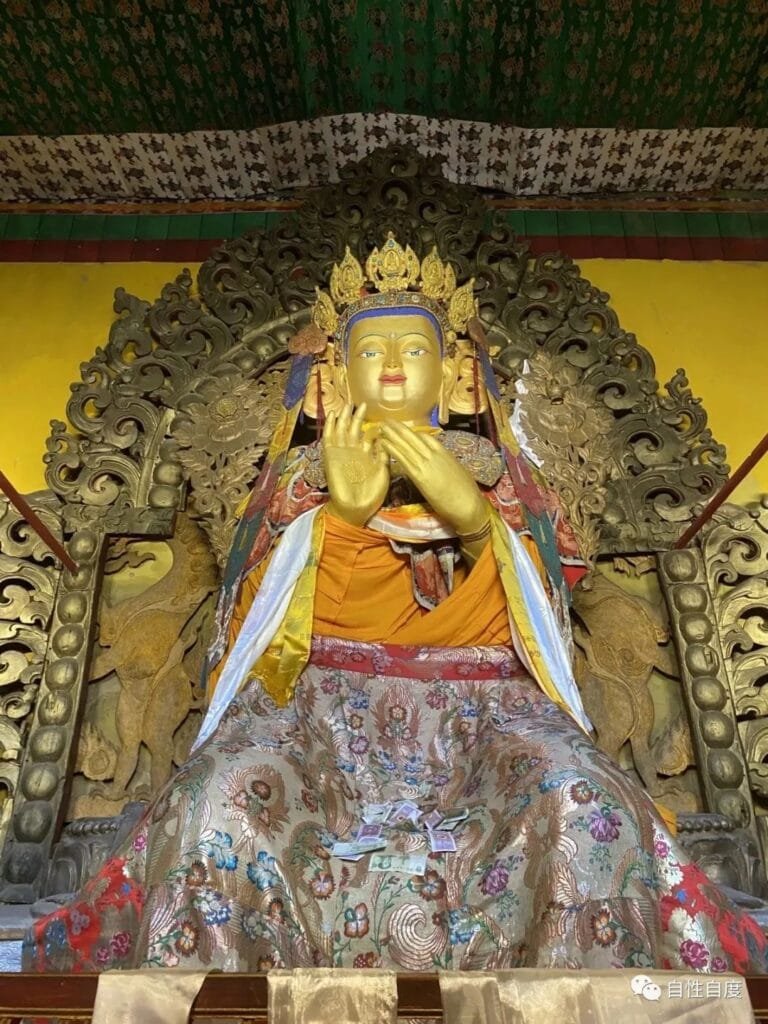
Lubum Lhakang
To the right of Dusum Lhakhang lies “Lubum Lakang”. In its front, there are two smaller pagodas painted in white, known as “Lubum Pagoda”. At the rear, three silver Stupa are placed side by side. The centre Stupa is the Tomb Stupa of the third Dalai lama (Sonan Gyatso), measuring 6.16 meters. Towards the north, there is the Tomb Stupa of the Fourth Dalai (Yunten Gyatss), measuring 5.57 meters, with a 1-meter-high wooden-waisted seat, making it a total of 6.57 meters in height.
Towards the south, there is the (Desi Trinley Gyatso) Regent’s Tomb Stupa, which measures 4.6 meters in height. The tower is adorned with silver and embedded with jewellery, making it exquisite and luxurious. It took 14,800 taels of silver to construct it, which was used solely by the third and fourth Dalai Lamas.
Kangyur Lhakhang
On the second floor of the hall, there is only one “Kangyur Lakhang”, while the rest of the space is used as a warehouse. Kangyur has many classics, and three precious collections are present. One of them is the ideal version of the Great Tibetan Sutra, which was sent by Landlord Mu Zeng from Yunnan during the late Ming Dynasty. The other one is the Kangxi wood-cut scriptures of the Qing Dynasty. The last one is from 1675 (the fourth year of Kangxi), where Diba Lobsang Tudop celebrated the birthday of the Dalai Lama using gold.
Jampa Tongdol Lhakang
On the third floor of the hall, there is a small hall named “Jampa Tongdol Lakang”. The giant gold-bronze statue of Jampa Tongdol is believed to be the statue of Matriye Buddha when he was eight years old, built by the Local king Neu under the blessing of Tsongkhapa. The statue depicts a childish appearance, making it one of the best Buddha statues. In front of the Buddha statue, there is a conch, which is believed to be a magical object given to him when Tsongkhapa ordered Jamchen Choeje to build Drepung Monastery. Inside the statues have countless relics like Lama Tsongkhapa’s hair, his clothes, the hair of Master Asanga and his dress. etc
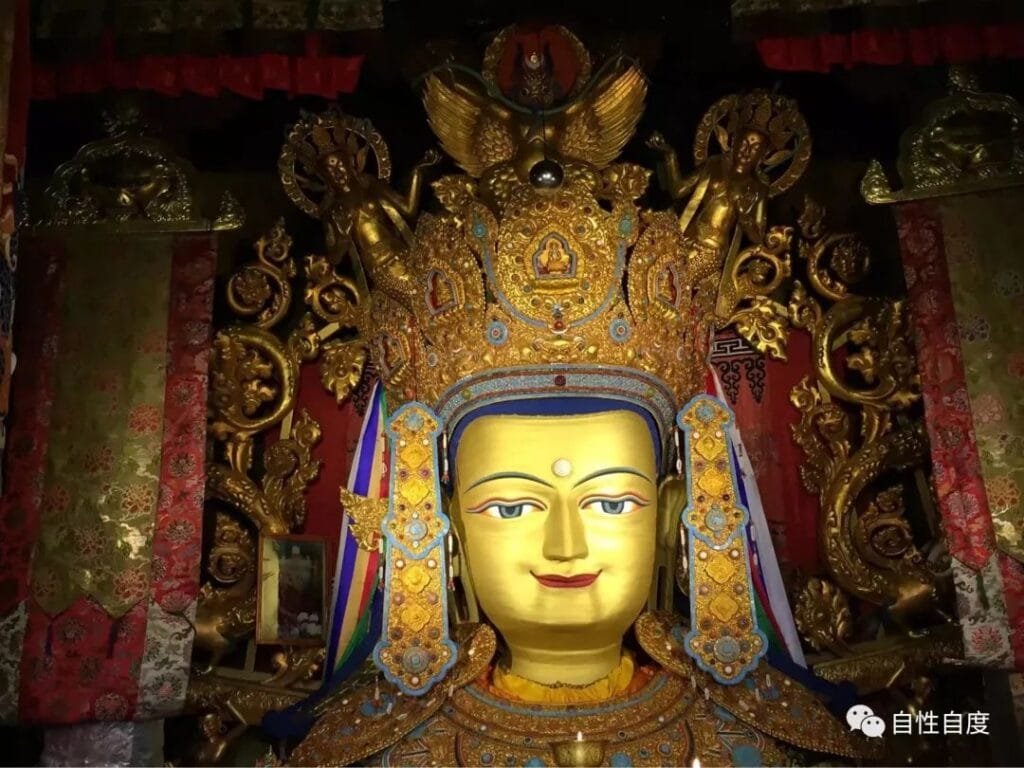
The Jampa Tongdol Lhakhang boasts a remarkable square spire golden roof. A Chinese Character plaque, bearing the inscription (穆隆元善)Mulong Yuanshan, hangs on the temple’s entrance. The plaque is adorned with an oval seal that reads “the seal of Mengqiu in the year of the Bingwu year of Daqing Daoguang”. On the back, two seals are engraved: one bears the words “Don’t Mu’s” and the other reads “The seal of Qishan”. This plaque was carved and donated by Qi Shan, who was then serving as a minister in Tibet, in July 1846 (the 26th year of Qing Daoguang) upon his transfer from Tibet.
Shakyamuni Buddha Hall
The fourth level of the temple houses the Shakyamuni Buddha Hall, which features a grand statue of Sakyamuni, believed to have been crafted from 500 taels of silver. On both sides stand 13 silver towers. The Arhat Hall is reserved for the ancestors of Buddhism, Arhats, and other deities, as well as the primary statue of the living Buddha of Drepung Monastery. The temple’s golden roof is accentuated by a splendid Gyaltsen (victory banner), inspired by mainland architecture.
Four Major Dratsang of Drepung Monastery
Dratsang is not only the educational unit of the Monastery, but also the top-level management institution below Tsokchen also referred to as the “College of Scriptures”. Initially, Drepung Monastery was divided into seven Dratsang, namely Gomang, Deyang, Loseling, Ngaba, Shakor, Tosamling, and Dulwa. Each of the seven disciples of Jamyang Choeje was in charge. Later, it merged into the current four large Dratsangs of Loseling, Gomang, Deyang, and Ngaba. The first three are Mahayana Dratsang, and the latter one is Tantric Dratsang.
Loseling College of Drepung Monastery
Loseling Dratsang is the largest Dratsang in Drepung Monastery, covering an area of approximately 1,860 square meters, comprising two parts: the sutra hall and the Buddhist temple. The Assembly Hall has an area of 1,053 square meters, with 102 columns. The meridians (about 60 meters long) on both sides of the sutra hall stand on the wall, which is full of various classic sutra. The furnishings in the classic hall are also extremely lavish. Behind the sutra hall is the Jampa Buddha Hall, which primarily worships the statue of the Maitreya Buddha. The Buddhist hall is connected with three rooms, and the front is connected.
The middle room is 11 meters wide and 6 meters deep. The back of the Buddhist temple is full of various Buddhas and Buddhisaatva, and only a narrow passage is left in front of pilgrims. There are 23 Khamtsen under its jurisdiction. The highest monk is Khenpo.
Gomang Dratsang
Gomang Dratsang is the second largest in the area, with two distinct parts – the sutra hall and the temple. The Dratsang spans over 985.5 square meters and consists of 102 columns, measuring 36 meters from east to west and 27 meters from north to south. The sutra hall is divided into three Lhakangs – Jigche Lhakang, Dolma Lakang, and Buddha Lhakang, and is served by monks from Inner Mongolia, Qinghai, and Naqu. Additionally, there are 16 Khamtsen under its jurisdiction.
Deyang Dratsang
In contrast, Deyang Dratsang is the smallest college, covering an area of approximately 952 square meters. The sutra hall is 7 rooms wide, with 62 columns, and a total area of 375 square meters. At the back of the sutra hall is the Buddha Hall, which is 7 rooms wide and 2 rooms deep, covering an area of 54.74 square meters. A tac-format screen door is located in the middle of the front, measuring 12.1 meters in width. There are two 1.7-meter-square-room warehouses on either side. The monastery and kitchen are located on the left, with irregular shapes. The Main statue inside the hall is Maitreya Buddha.
Ngaba Dratsang
Ngaba Dratsang, situated on the right side of the Tsokchen Assembly Hall, is the Tantric Academy of Drepung Temple. The construction of this academy is unique as it comprises a closed courtyard in the front, surrounded by monk’s rooms and a sutra hall at the back. The sutra hall is spread over an area of 467 square meters, with 9 rooms in width and 7 rooms in depth, supported by 48 columns. The walls of the hall are adorned with murals depicting tantra materials.
Jikchi Lhakang is located at the back of the sutra hall, covering an area of 56 square meters, with 3 wide rooms and 2 deep rooms. It houses a few Buddha statues, which are tall and fierce, with a horrifying appearance. The statue of Ra Lotsawa is said to be missing only one finger, which is quite intriguing. One of the three major tantras, the statue of Yamantaka, with 9 heads and 34 arms, is also present in the Hall. It is believed to be the incarnation of Manjushri Bodhisattva and was personally crafted by the Lama Tsongkhapa.
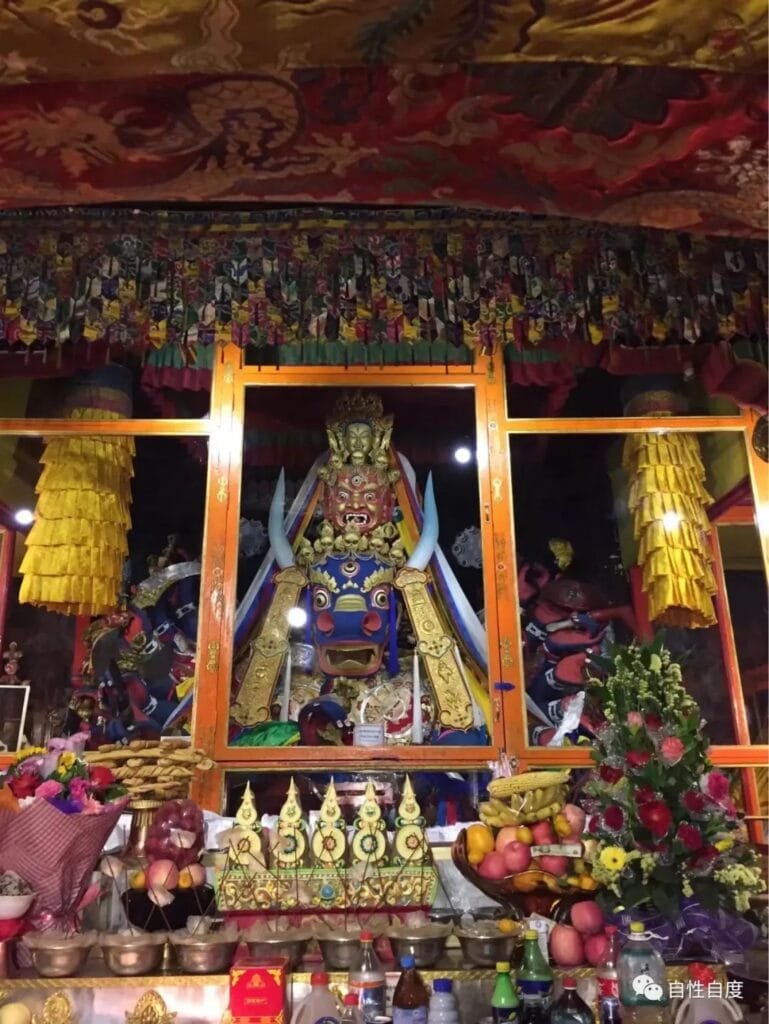
Drepung Monastery: A Treasure Trove of Tibetan Cultural and Religious Artifacts
Drepung Monastery, recognized as the largest monastery in Tibet, is a repository of a vast array of invaluable cultural and religious artefacts, each telling a story of Tibet’s rich history and spiritual depth.
Porcelain Collections: A Journey Through Dynasties
- Diverse Dynasty Pieces: The monastery’s porcelain collection spans several dynasties, from the early Song period to the Ming and Qing Dynasties. This collection primarily consists of pressure cups and small bowls, each piece reflecting the artistic evolution over the centuries.
Thangka Art: Ming and Qing Dynasty Masterpieces
- Elegance in Fabric: The monastery is adorned with numerous thangkas, mainly from the Ming and Qing Dynasties. Of particular note are four sets of thangkas in the Tsokchen assembly hall, showcasing the “four treasures” in their elegant and luxurious depiction.
Buddhist Scriptures: A Sacred Compilation
- 108 Pieces of Wisdom: Among its most treasured possessions is a set of “Buddhist Scriptures,” encompassing 108 pieces packed in 54 special wooden boxes. The meticulous printing and binding of these scriptures make them a true jewel in the monastery’s collection.
Statues and Stupas: A Legacy in Bronze
- Manjushri Statue: The monastery boasts a 1.29-meter carved statue of Manjushri, seated on a beautifully crafted sandalwood round mirror seat, believed to be a gift from Emperor Shunzhi to the Fifth Dalai Lama.
- Bronze Statuary: The collection also includes thousands of bronze statues, featuring Buddhas, Bodhisattvas, and various ancestors. Notably, the Yongle period of the Ming Dynasty contributed some of the most exquisite and valuable bronze Bodhisattva statues.
Weapons and Armor: Glimpses of Tibetan Military History
- Ancient Warfare Artifacts: Drepung Monastery also preserves a collection of ancient weapons and armor. The armor in the Tsokchen Hall, in particular, offers a comprehensive and valuable insight into Tibetan cultural and military history.
Drepung Monastery stands as a testament to Tibet’s spiritual and cultural grandeur, offering visitors and researchers alike a unique opportunity to explore a rich array of artifacts that span centuries. Each item in its collection, whether it be a delicate porcelain piece or a robust suit of armor, weaves into the narrative of Tibet’s fascinating history and enduring spiritual traditions.




